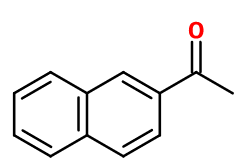Oranger Crystals®
Synthétique
Floral > Orange Blossom > Anthranilic > Almondy

Crédits photo: ScenTree SAS
Other names :
Methyl Naphtyl Ketone ; 1-naphthalen-2-ylethanone ; Beta-acetonaphthalene ; 2-acetonaphthanone ; 2-acetylnaphthalene ; Cetone D ; 1-(2-naphthalenyl)-ethanone ; Methyl 2-naphthyl ketone ; MNK ; 1-naphthalen-2-yl-ethanone ; 2-naphthyl methyl ketone
Volatility :
Base
Uses in perfumery :
Oranger Crystals® is used in orange and white flowers notes for a warmth supply. Used in soaps and detergents for its stability. Tends to flatten formulas if overdosed.
Natural availability :
Oranger Crystals® is not available in its natural state.
Year of discovery :
1892
Other comments :
Comparing it to other notes of the same type as Methyl Anthranilate or Dimethyl Anthranilate, Oranger Crystals has a distinctive almond smell.
Price Range :
€€
Stability :
Stable in perfumes and diverse functional bases, except acid cleaners and bleaches. Very stable in fabric care products.

Crédits photo: ScenTree SAS
- Molecular formula :
- C12H10O
- Molecular Weight :
- 170,21 g/mol
- Density :
- <1,5
- Flash Point :
- 154°C
- Fusion Point :
- 54°C
- Appearance :
- White solid
- Log P :
- 2,9
- Boiling Point :
- 301°C
- Detection Threshold :
- Donnée indisponible.
Synthesis route :
Oranger Crystals® is synthesized from naphthalene by a Friedel-Craft acetylation, and by reacting it with chloroacetic acid for example, in the presence of aluminum chloride. The more polar the solvent used in the synthesis, the larger the quantity of beta isomer in Orange Crystals®. The alpha product is not desired.
Synthesis precursor :
Oranger Crystals® is not a precursor to the synthesis of another compound of olfactory interest.
Isomerism :
alpha-Methyl Naphthyl Ketone, also known as Oranger Liquid®, is a liquid that also has a smell similar to orange blossom. This compound is nevertheless dissociated from Oranger Crystals® in perfumery.
Diphenyl Oxide is an isomer of Oranger Crystals®, but it has a very different smell as it is rosy and fruity.
- EINECS number :
- 202-216-2
- FEMA number :
- 2723
- JECFA number :
- 811
- FLAVIS number :
- 07.013
- Allergens :
- This ingredient does not contain any allergen.
- IFRA :
- This ingredient is restricted by IFRA
- Restriction type :
- RESTRICTION
- Cause of restriction :
- PHOTOTOXICITY
- Amendment :
- 49
- Comments :
- The Standard is set due to the phototoxic effects of Methyl β-naphthyl ketone. For more detailed information on the application of this Standard, please refer to the note on phototoxic ingredients in chapter 1 of the Guidance for the use of IFRA Standards.
- Quantitative limit on the use :
-
Cat.1 Cat.2 Cat.3 Cat.4 Cat.5A Cat.5B Cat.5C Cat.5D Cat.6 0,2 % 0,2 % 0,2 % 0,2 % 0,2 % 0,2 % 0,2 % 0,2 % 0,2 % Cat.7A Cat.7B Cat.8 Cat.9 Cat.10A Cat.10B Cat.11A Cat.11B Cat.12 No Restriction 0,2 % 0,2 % No Restriction No Restriction 0,2 % No Restriction 0,2 % No Restriction - Restriction type :
- RESTRICTION
- Cause of restriction :
- PHOTOTOXICITY
- Amendment :
- 49
- Quantitative usage limits :
-
Cat.1 Cat.2 Cat.3 Cat.4 Cat.5 Cat.6 Cat.7 Cat.8 Cat.9 Cat.10 Cat.11 0,2 % 0,2 % 0,2 % 0,2 % 0,2 % 0,2 % No Restriction 0,2 % No Restriction No Restriction No Restriction
To learn more about IFRA's standards : https://ifrafragrance.org/safe-use/library
ScenTree is solely responsible for the information provided here.

